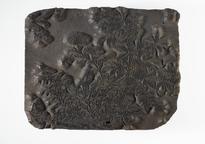

Model of power loom invented by George White (scale 1:3)
- Made:
- c.1829 in United Kingdom
- inventor:
- George White
Model of power loom invented by George White (scale 1:3), United Kingdom, c. 1829.
This is a model of a plain calico loom, invented by G. White, of Glasgow. Its chief features are that the shuttle is picked by springs which give a uniform throw, irrespective of the speed of the loom, and that the levers and cams are all driven from one shaft. From the driving shaft, motion is taken through a crank and connecting rod to an upright shaft, to which is keyed a horizontal arm with two rollers upon it. One of these causes an arm, centred below, to rock through a small angle, and so give motion to the healds ; it also moves a long horizontal rod endways, thereby compressing springs which pick the shuttle. The other roller oscillates a frame connected with the lay, and so effects the beating up. The cloth is taken in by motion derived from a ratchet wheel, the pawl of which is worked from the horizontal arm which gives motion to the healds and lay. The movement of the pawl is controlled by a finger which presses upon the cloth beam, so that less motion is communicated to the beam as the diameter of the roll increases.
Details
- Category:
- Textiles Machinery
- Object Number:
- 1867-46
- Measurements:
-
overall: 760 x 900 x 490 mm
- type:
- power loom
- credit:
- Royal Society of Arts




